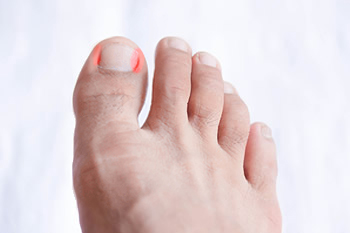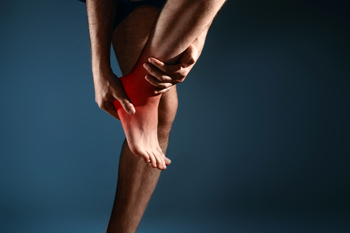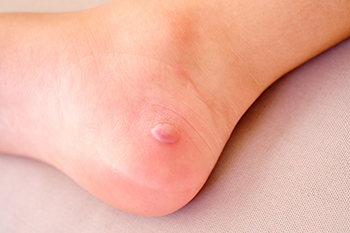Items filtered by date: June 2025
Dealing With Ingrown Toenails

Ingrown toenails occur when the edge of the toenail grows into the surrounding skin, leading to pain, swelling, and sometimes infection. Common causes include improper nail trimming and cutting nails too short or rounded. Tight-fitting shoes, injury, or genetic predisposition are other factors. Symptoms typically begin with redness, tenderness, and swelling along the nail edge. As the condition progresses, the area may become warm, painful, and drain pus if infected. It may be difficult to wear shoes or walk comfortably. A podiatrist can diagnose an ingrown toenail through a physical exam. Treatment depends on the severity and may include soaking, proper trimming, and antibiotic ointments. In more advanced cases, a minor procedure, called nail avulsion, may be performed to remove part or all of the affected nail. This helps relieve pain and prevent recurrence. If you are dealing with a painful ingrown toenail, it is suggested that you make an appointment with a podiatrist for evaluation and treatment.
Ingrown toenails can become painful if they are not treated properly. For more information about ingrown toenails, contact one of our podiatrists of Pocono Foot & Ankle Consultants. our doctors can provide the care you need to keep you pain-free and on your feet.
Ingrown Toenails
Ingrown toenails occur when a toenail grows sideways into the bed of the nail, causing pain, swelling, and possibly infection.
Causes
- Bacterial infections
- Improper nail cutting such as cutting it too short or not straight across
- Trauma to the toe, such as stubbing, which causes the nail to grow back irregularly
- Ill-fitting shoes that bunch the toes too close together
- Genetic predisposition
Prevention
Because ingrown toenails are not something found outside of shoe-wearing cultures, going barefoot as often as possible will decrease the likeliness of developing ingrown toenails. Wearing proper fitting shoes and using proper cutting techniques will also help decrease your risk of developing ingrown toenails.
Treatment
Ingrown toenails are a very treatable foot condition. In minor cases, soaking the affected area in salt or antibacterial soaps will not only help with the ingrown nail itself, but also help prevent any infections from occurring. In more severe cases, surgery is an option. In either case, speaking to your podiatrist about this condition will help you get a better understanding of specific treatment options that are right for you.
If you have any questions, please feel free to contact our offices located in Stroudsburg, Nazareth, and Easton, PA . We offer the newest diagnostic and treatment technologies for all your foot care needs.
Heel Pain Can Indicate Bursitis

If you are experiencing heel pain, it could be a sign of bursitis, which is an inflammation of the fluid-filled sacs, or bursae, located at the back of your heel. These sacs help reduce friction between your heel bone, skin, and Achilles tendon. Bursitis typically develops from repetitive pressure, wearing ill-fitting shoes, or conditions like arthritis or heel abnormalities. The pain is usually felt at the back of the heel and may be accompanied by swelling, tenderness, and, in some cases, redness or warmth. It can make walking or standing uncomfortable and may worsen with physical activity. A podiatrist can accurately diagnose bursitis through a physical exam and imaging studies, if necessary. Treatment options include anti-inflammatory medications, fluid drainage, custom orthotics, or protective padding to reduce pressure on the affected area. In severe cases, surgery may be required to remove the inflamed bursa or correct structural issues in the heel. If you have heel pain, it is suggested that you promptly schedule an appointment with a podiatrist for an accurate diagnosis and effective treatment.
Many people suffer from bouts of heel pain. For more information, contact one of our podiatrists of Pocono Foot & Ankle Consultants. our doctors can provide the care you need to keep you pain-free and on your feet.
Causes of Heel Pain
Heel pain is often associated with plantar fasciitis. The plantar fascia is a band of tissues that extends along the bottom of the foot. A rip or tear in this ligament can cause inflammation of the tissue.
Achilles tendonitis is another cause of heel pain. Inflammation of the Achilles tendon will cause pain from fractures and muscle tearing. Lack of flexibility is also another symptom.
Heel spurs are another cause of pain. When the tissues of the plantar fascia undergo a great deal of stress, it can lead to ligament separation from the heel bone, causing heel spurs.
Why Might Heel Pain Occur?
- Wearing ill-fitting shoes
- Wearing non-supportive shoes
- Weight change
- Excessive running
Treatments
Heel pain should be treated as soon as possible for immediate results. Keeping your feet in a stress-free environment will help. If you suffer from Achilles tendonitis or plantar fasciitis, applying ice will reduce the swelling. Stretching before an exercise like running will help the muscles. Using all these tips will help make heel pain a condition of the past.
If you have any questions, please feel free to contact our offices located in Stroudsburg, Nazareth, and Easton, PA . We offer the newest diagnostic and treatment technologies for all your foot care needs.
Heel Pain in the Morning?
Causes of and Caring for Blisters

Blisters on the feet often form from friction, usually when skin rubs against tight or poorly fitted shoes. This repeated pressure separates layers of skin, allowing fluid to collect. Blisters can also appear due to burns, cold exposure, allergic reactions, or infections. On the feet, these fluid-filled pockets can become painful, especially when walking. Popping a blister yourself is not recommended, as breaking the skin increases the risk of infection. People with diabetes or circulation issues should be especially cautious, as blisters can become infected more easily. Signs of infection include redness, swelling, warmth, or pus. A podiatrist can evaluate the blister, relieve pressure safely, and recommend treatment to reduce pain and protect the surrounding skin. If you have developed a problematic blister on your foot, it is suggested that you schedule an appointment with a podiatrist for an exam and treatment options.
Blisters are prone to making everyday activities extremely uncomfortable. If your feet are hurting, contact one of our podiatrists of Pocono Foot & Ankle Consultants. our doctors can provide the care you need to keep you pain-free and on your feet.
Foot Blisters
Foot blisters develop as a result of constantly wearing tight or ill-fitting footwear. This happens due to the constant rubbing from the shoe, which can often lead to pain.
What Are Foot Blisters?
A foot blister is a small fluid-filled pocket that forms on the upper-most layer of the skin. Blisters are filled with clear fluid and can lead to blood drainage or pus if the area becomes infected.
How Do Blisters Form?
Blisters on the feet are often the result of constant friction of skin and material, usually by shoe rubbing. Walking in sandals, boots, or shoes that don’t fit properly for long periods of time can result in a blister. Having consistent foot moisture and humidity can easily lead to blister formation.
Prevention & Treatment
It is important to properly care for the affected area in order to prevent infection and ease the pain. Do not lance the blister and use a Band-Aid to provide pain relief. Also, be sure to keep your feet dry and wear proper fitting shoes. If you see blood or pus in a blister, seek assistance from a podiatrist.
If you have any questions, please feel free to contact our offices located in Stroudsburg, Nazareth, and Easton, PA . We offer the newest diagnostic and treatment technologies for all your foot care needs.
Bunion Surgery May Be the Right Step for Long Term Relief

When bunion pain becomes a daily struggle and non-operative treatments no longer help, surgery may be the next option. Bunion surgery involves realigning the bones, ligaments, and tendons to restore the natural position of the big toe. There are several types of procedures, and the right one depends on the severity of the deformity and the patient’s activity level and goals. Recovery time varies, but most people can return to wearing regular shoes within a few months. With the right follow up care, surgery can reduce pain, improve foot function, and allow for greater freedom in footwear choices. If your bunions are limiting your lifestyle or causing constant discomfort, it is suggested that you see a podiatrist to discuss whether surgery is right for you.
Foot surgery is sometimes necessary to treat a foot ailment. To learn more, contact one of our podiatrists of Pocono Foot & Ankle Consultants. our doctors will assist you with all of your foot and ankle needs.
When Is Surgery Necessary?
Foot and ankle surgery is generally reserved for cases in which less invasive, conservative procedures have failed to alleviate the problem. Some of the cases in which surgery may be necessary include:
- Removing foot deformities like bunions and bone spurs
- Severe arthritis that has caused bone issues
- Cosmetic reconstruction
What Types of Surgery Are There?
The type of surgery you receive will depend on the nature of the problem you have. Some of the possible surgeries include:
- Bunionectomy for painful bunions
- Surgical fusion for realignment of bones
- Neuropathy decompression surgery to treat nerve damage
Benefits of Surgery
Although surgery is usually a last resort, it can provide more complete pain relief compared to non-surgical methods and may allow you to finally resume full activity.
Surgical techniques have also become increasingly sophisticated. Techniques like endoscopic surgery allow for smaller incisions and faster recovery times.
If you have any questions, please feel free to contact our offices located in Stroudsburg, Nazareth, and Easton, PA . We offer the newest diagnostic and treatment technologies for all your foot care needs.

